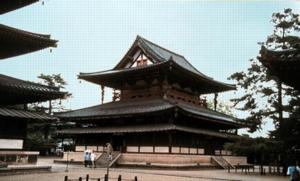
City in southern Honshu, Japan's capital 710 - 784
During the 8th century, when Nara was the capital of Japan, the city was known as Heijo-kyo. It is located in the hills 40 km east of Osaka.
The period of Nara's role as the nation's capital was a time of much Buddhist building activity, and today Nara is justly famous for its many Buddhist buildings and works of art. A Japanese proverb says: "See Nara and die": Have your heart filled with peace and die contented having seen the wonders of Nara.
Among its many treasures are the Seven Great Temples and many lesser ones, a five storied pagoda, the Great Buddha of the Todai Temple, which also housed countless jewels, calligraphy, sculptures, paintings, musical instruments and other artifacts in a wooden storehouse; these treasures are now kept in a fireproof building.
Southwest of the city is the Horyuji temple complex. Its main hall (kondo) is the oldest existing wooden structure on earth. The complex contains several other ancient buildings and exquisite paintings and carvings.
Today Nara is a major centre of Japanese and international tourism and a declared national monument. Its atmosphere of ancient Japanese life contrasts starkly with the industrial city of Osaka.

The kondo of the Horyuji temple near Nara.

A wall painting (left) from the kondo (right) of the Horyuji temple near Nara on Japanese postage stamps.